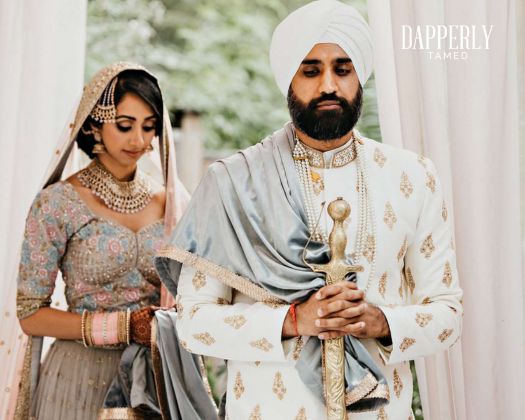A Glimpse into Sikh Wedding Ceremonies: A Male Perspective
Introduction:
Sikh weddings, known as 'Anand Karaj' or 'Blissful Union,' are a celebration of love, tradition, and spiritual unity. Rooted in rich customs and rituals, Sikh weddings are a beautiful blend of pre-wedding, wedding, and post-wedding ceremonies that span over several days. In this article, we'll explore the intricate tapestry of Sikh wedding ceremonies, offering a male perspective on the profound rituals and vibrant celebrations that define this sacred union.
Pre-Wedding Rituals:
Roka and Thaka:
The journey of a Sikh wedding begins with the fundamental element of parental consent. The Roka and Thaka ceremonies symbolize the wholehearted support and blessings of the parents. It's a beautiful exchange where the father of the bride visits the groom's home, applying a tilak on his forehead and presenting gifts, reciprocated by the groom's parents at the bride's home.
Kurmai:
The formal engagement ceremony involves prayers, exchange of rings, and symbolic gifts. The groom presents the bride with a ring, and in return, the bride's family gifts him a kara (steel bangle) and a kripan, symbolizing Sikh heritage.
Shagan:
Gifts from the bride's family are sent to the groom's home, featuring a delightful array of fruits, dry fruits, sweets, coconuts, and clothes.
Chunni Chadana:
Female relatives of the groom visit the bride's home, presenting her with an outfit, jewelry, and makeup. The groom's mother covers the bride's head with a blessed headscarf, symbolizing acceptance into the family.
Maiya:
The cleansing ceremony involves applying oil to the hair and turmeric paste on the body. Female relatives and guests sing traditional wedding songs, creating a joyful atmosphere.
Vatnaa:
Married women in the family massage the bride and groom with a specially prepared paste made of turmeric, barley, and mustard, accompanied by singing and happiness.
Karahi Chadana:
A significant ceremony where a meal is cooked in a large wok (karahi) to be served to guests visiting the house during the days leading up to the wedding.
Warna:
Money is waved around the couple's heads, dropped, and then donated to charity, symbolizing the casting away of evil energy.
Gaana:
A red thread is tied on the bride's left wrist and the groom's right wrist for protection against negative premonitions.
Mehndi:
Henna paste is applied decoratively to the bride's hands and feet, a vibrant and artistic pre-wedding ritual.
Chura and Kalire:
The bride receives a set of red and white bangles (chura) blessed by washing them with curd and rosewater. Kalire, umbrella-shaped metallic ornaments, are tied to the chura, offering blessings.
Wedding Attire:
Sikh grooms prefer traditional attire, wearing a kurta, often white, with an achkan or sherwani. The groom pairs it with a churidar pajama, traditional mojri, and a turban, typically of pink cloth.
Sikh brides wear ornate, embroidered salwar kameez or lehengas, with traditional jewelry like necklaces, earrings, bangles, and mangtika, usually in red or other vibrant colors.
Wedding Rituals:
Sehra Bandi:
Before departing for the wedding venue, the groom's turban is tied by his father, and his face is covered with a sehra, made of golden ribbons or pearls.
Soorma and Kalgi:
The groom's sister-in-law applies kohl to his forehead, defending against negative energy. The groom's sister ties jewelry to his turban, symbolizing a playful demand for gifts.
Baraat:
The groom, traditionally on a decorated horse, travels to the bride's house or Gurdwara, accompanied by family and friends dancing and singing.
Milni:
The baraat is welcomed by the bride's family, with hymns and garlands exchanged between the families, symbolizing unity.
Anand Karaj:
The heart of the Sikh wedding, taking place at the Gurdwara during the daytime. The ceremony involves the couple sitting together, facing the Guru Granth Sahib, and participating in the reading of hymns and vows.
Lavan Pheras:
The priest conducts the four lavan or stanzas from the Guru Granth Sahib, with the couple circumambulating the holy book, symbolizing their spiritual journey together.
Anand Sahib:
Hymns are sung, an ardaas is offered, and a random hymn from the Guru Granth Sahib is recited, marking the completion of the wedding ceremony.
Langar:
A vegetarian lunch is served to the guests at the Gurdwara, followed by a ceremony called Roti, signifying the bride's first meal as a married woman.
Post-Wedding Rituals:
Sadaa Suhagan:
The bride changes into an outfit and accessories presented by the groom's family, receiving blessings for a life free from widowhood.
Reception:
A celebratory reception hosted by the groom's family, inviting friends and family to share an extravagant meal and engage in singing and dancing.
Doli:
The bride's departure from her paternal home, marked by throwing rice grains for prosperity. She receives a warm welcome at the groom's home.
Conclusion:
A Sikh wedding is a tapestry of customs, rituals, and joyous celebrations that unite two souls in a sacred bond. From pre-wedding ceremonies that involve the entire family to the spiritual sanctity of the Anand Karaj and the post-wedding festivities, each moment is a testament to the rich Sikh tradition. Embracing the significance of every ritual, Sikh weddings are a harmonious blend of spirituality, love, and cultural richness, creating memories that last a lifetime.









